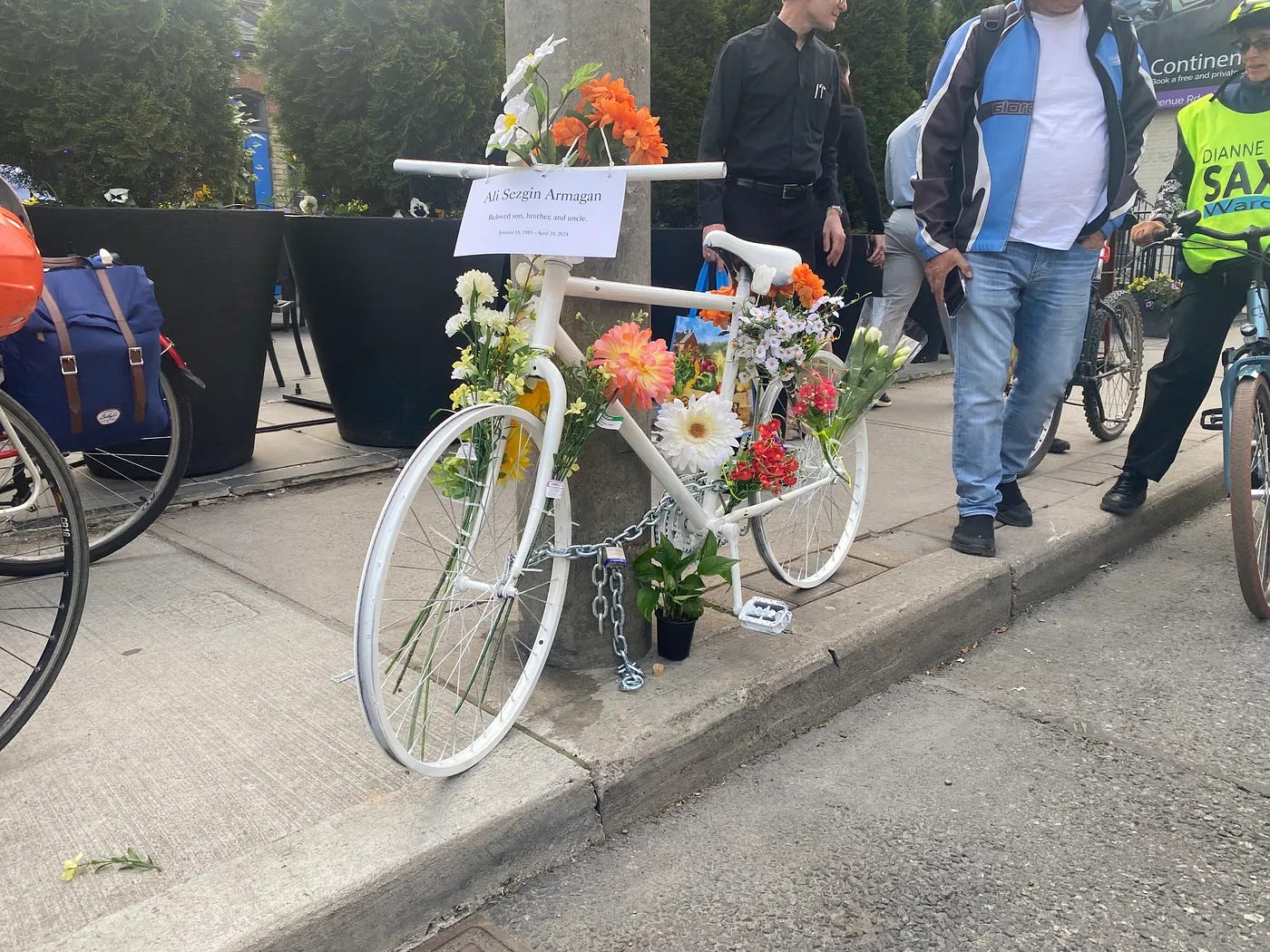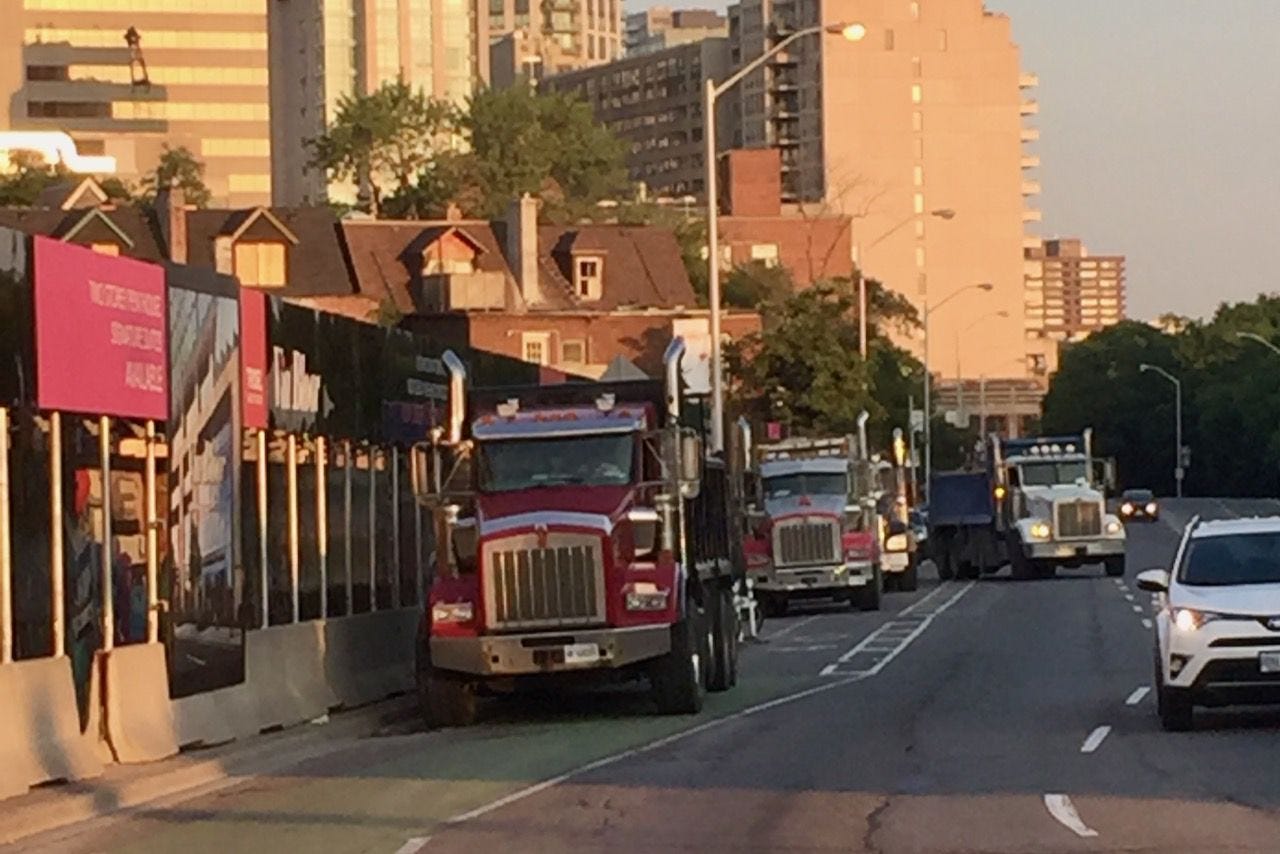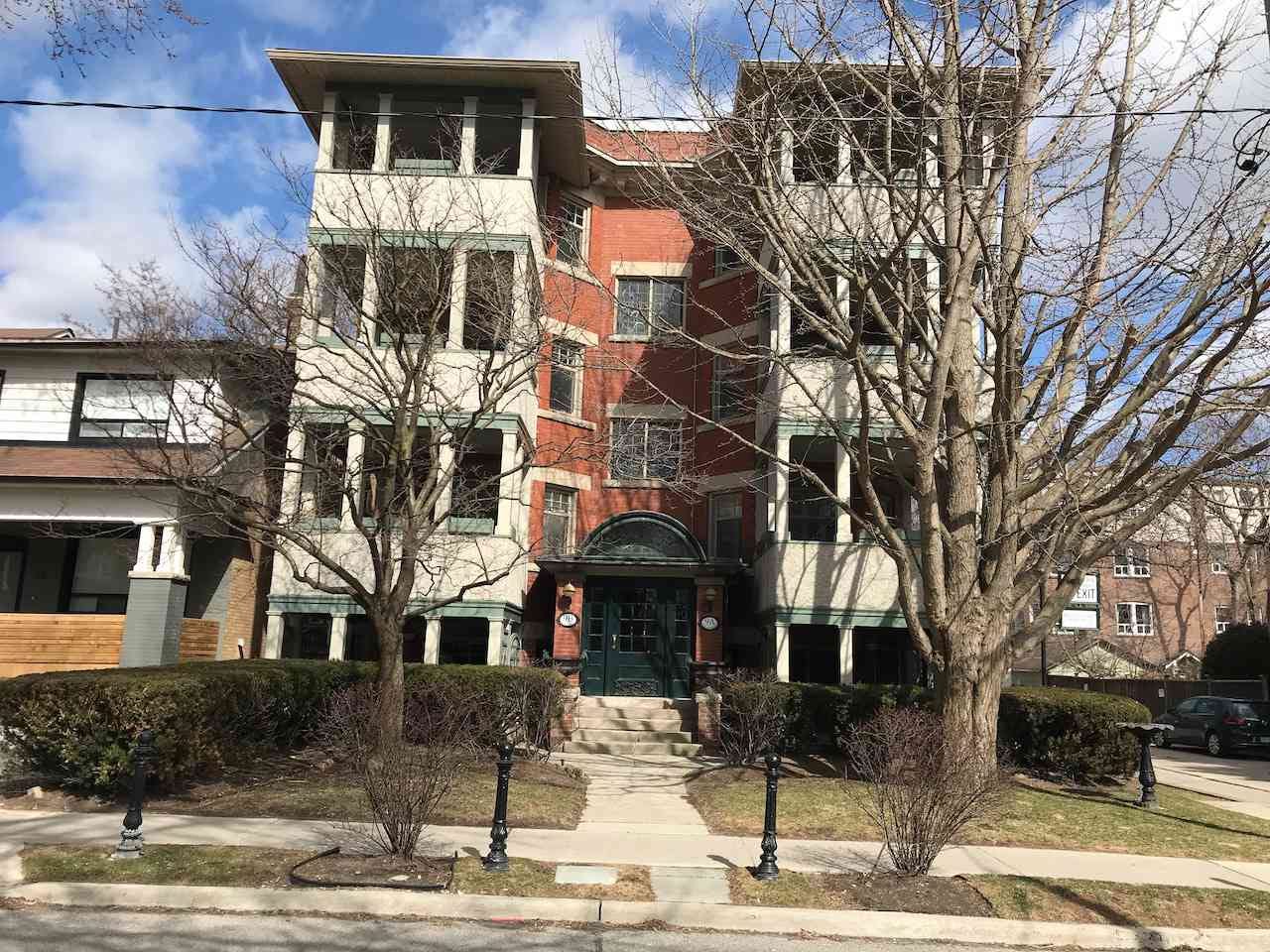Toronto has too many Ghost Bikes
The construction industry kills another cyclist and I attend another ride and installation.
Ali Sezgin Armagan was killed by the construction industry last Tuesday night, and in what has become a regular activity, Joey Schwartz of Advocacy for Respect for Cyclists (ARC) organized a group ride to the spot where it happened and installed a Ghost Bike a week later.
It was a big crowd, not the biggest I have seen, blocking the three southbound lanes of Avenue Road, a major traffic sewer.
It has become a family thing with everyone, including the dogs, doing the trip. I share Emma’s hope that this will be her last memorial bike ride.
Many have noted that there have been three deaths on this stretch of road in the last few years, and there has been talk about fixing it forever. Two of those three deaths were caused by the construction industry.
The deaths have been happening for a long time as well; my first ghost bike ride was in 2006 for Hubert Van Tol, a professor at the University of Toronto who I rowed with at Hanlan Boat Club. He was also killed by the construction industry, right hooked by a dump truck. Note how “Cycling advocates are calling for regulations requiring trucks to have sideguards installed.” We still are.
A moment of silence for Ali Sezgin Armagan. He was a recent immigrant from Turkey, doing Uber deliveries. Many on social media are blaming him, but according to the Star, “In a news release, police said a 52-year-old man is facing a charge of careless driving causing bodily harm or death.”
The city has been studying this stretch of road for years, but progress has been slow. The latest report indicates that the majority of people like it the way it is: three lanes of fast-moving traffic in each direction.
“Participants expressed strong concerns about the impact of lane reductions on congestion, traffic flow, and potential for increased motor vehicle volumes on side streets. Some participants indicated concern about the environmental impacts of increased idling, and safety concerns on side streets that could be caused by potential increases to traffic. Many also disputed the necessity of the changes given perceived low levels of walking and cycling in the neighbourhood currently.”
I am reminded of Brent Toderian’s line, “You can't justify a bridge by the number of people swimming across a river.”- there are low levels of walking and cycling because it is a deathtrap.
But there is a bigger issue here than just road design. People have criticized me for saying these cyclists were killed by the construction industry, but the majority of them were caused by construction vehicles that are too big, going too fast, have shitty visibility, have no sideguards, and with insufficiently trained drivers. I wrote about this for Treehugger when Miguel Joshua Escanan was killed by the driver of a ready-mix truck on Avenue Road in 2021, and I am reposting it here.
It's Time for the Construction Industry to Prioritize People Who Walk or Bike
It seems there is a fatal cost of doing business. This has to stop. From August, 2021
A ghost bike ride was held in Toronto recently for 18-year-old Miguel Joshua Escanan. These occur one week after people riding bikes are killed by drivers of cars or trucks. Organized by Advocacy for Respect for Cyclists (ARC), people assemble at a Toronto park and ride to the site of the killing, where a white ghost bike is fastened to the nearest pole. I have been on many of these—two for people I knew personally.
Escanan was killed by the driver of a ready-mix concrete truck, as is a shockingly high proportion of dead cyclists. These are often called cement trucks, but cement is only one ingredient of concrete. Cement is a dry powder that can sit around; ready-mix concrete is made at a batching plant where cement, sand, aggregate, additives, and water is mixed together and shipped to the site in a tank that turns to keep the concrete from separating during transport. Concrete hardens after a certain amount of time, depending on mixes or additives, and there are limits to how long it can sit in the truck. According to Concrete Construction:
"ASTM C-94, Specification for Ready-Mixed Concrete, does place a time requirement on delivered concrete. The document states that discharge of the concrete shall be completed within 1 ½ hours after the introduction of the mixing water to the cement and aggregates, or the introduction of the cement to the aggregates."
That means the drivers of these trucks are on a tight schedule. Does this cause them to drive faster and take more chances? It's hard to tell because dump trucks kill a lot of cyclists, too, and the data are not separated by type of truck.
But the industry as a whole is killing a lot of Vulnerable Road Users, or VRUs in the studies. According to The Toronto Star, "A Star analysis of 15 years’ worth of data from 2006 to 2020 shows dump or cement trucks were involved in 11 per cent of all pedestrian deaths and more than a quarter of all cyclist deaths."
The construction boom in Toronto is huge: There are condos going up everywhere and there are trucks flying around the city to build them, predominantly out of concrete. After a cyclist complained to the local paper that bike lanes were being closed for construction, forcing cyclists to merge with traffic, a real estate agent responded:
"Was he really thinking that the condo should not be built so as not to block the bicycle lane? Has this person ever given any thought to the sizable contribution to the gross domestic product one condo building makes; has anyone?”
So there you have it said out loud: safety doesn't matter; the GDP does. The industry is perfectly capable of making construction sites safe for people walking or cycling; they do this in Copenhagen on every job site. In North America, they just don't want to spend the time or money or perhaps inconvenience drivers.
They don't want to spend the money on training drivers of these trucks, either. In an important story written after John Offutt's death by ready-mix concrete truck in November 2020, Ben Spurr wrote in The Toronto Star about how the driver had a long history of traffic offenses over the years but was still allowed to drive.
"The circumstances around Offutt’s death raise serious questions about provincial oversight of the drivers and companies that operate heavy trucks on Ontario roads. That oversight has been criticized for failing to mandate sufficient training for truck drivers and for allowing trucks that operate on city roads to go uninspected."
Then there are the trucks themselves. We have written many times about how in Europe, the industry is switching to trucks designed so that the driver has good visibility all around. In Canada, they won't even legislate side guards on trucks to prevent cyclists and pedestrians from going under the rear wheels. A study prepared for the City of Toronto in 2019 by Beth-Anne Schuelke-Leech of the University of Windsor found that the trucks had terrible visibility:
"Truck size is one factor that can reduce the impacts of collisions with VRUs. Smaller vehicles are less likely to lead to fatalities and serious injuries than trucks. The visibility in smaller vehicles is generally better than with larger trucks. Specific design features, such as seat location, the design of windows and mirrors, and the use of cameras and sensors can all help to improve driver visibility and reduce driver “blind spots”.
Side guards, which we have been complaining about for years, would also make a big difference. Trucks have to carry heavy metal to protect drivers of cars, but they never seem to care about Vulnerable Road Users.
"Rear underride guards are mandatory in Canada since these are intended to prevent vehicles from driving under the truck in a collision and these specific guards are not designed to help VRUs. Likewise, front bumpers are designed to protect the vehicle and not VRUs. Side impact guards have become more popular in recent years, as many cities adopt them to support greater safety forVRUs. Studies have shown that these side impact guards can be effective in reducing cyclist fatalities and serious injuries in sideswipe collisions where the cyclist and truck are headed in the same direction. They have also been shown to reduce pedestrian fatalities in the same types of collisions."
The industry could invest in better, safer trucks, but why should they? Nobody is making them do it. Nobody is making them put proper sidewalks and bike lanes around construction sites. Nobody is making them train their drivers better. Speed and profit matter more.
To be fair to the construction industry, many share responsibility for this killing. The road where it happened is a notorious car sewer, six lanes of fast-moving traffic that, as Joey Schwartz of ARC told the CBC Radio, people have been complaining about since the last century. But since the speed and comfort of drivers is paramount, the pace of change is glacial.
The city also shares responsibility for the number of trucks on the road because of the zoning regulations; development only happens in about 20% of the city on main streets or former industrial lands because low-density residential zones are sacred. So there are no more little apartment buildings permitted in residential areas, and all development is tall and concrete with massive concrete underground parking lots. In a world where concrete is responsible for 8% of carbon emissions. This has to change, but of course, it won't.
Getting people out of cars is also a big part of reducing our carbon footprint, which is why I devote so much space to writing about bikes and e-bikes. But we are not going to make much progress on that front if cyclists don't have a safe place to ride, or if construction vehicles keep killing them. The industry has to change; dead cyclists are not just a cost of doing business.


















That quote from the real estate agent is obscene, really. I thought Canadians were better than that. Too many ghost bikes out there, though it is a lovely gesture.
I have been without a car for a little over a year now. I live in a small town surrounded by open land but I still do not feel safe biking because motor vehicle drivers are often just blind to pedestrians and bicyclists. To bike in a big city like Toronto takes dedication and courage.